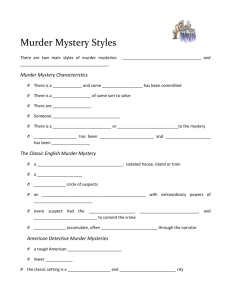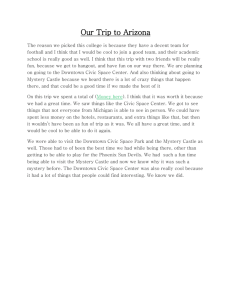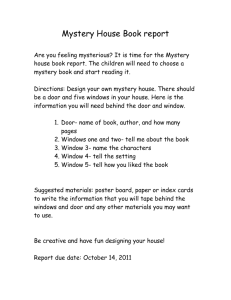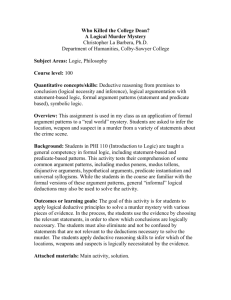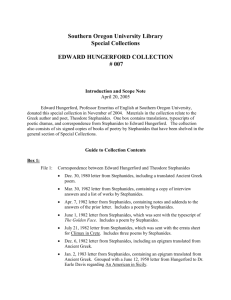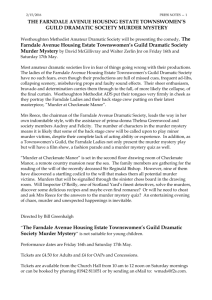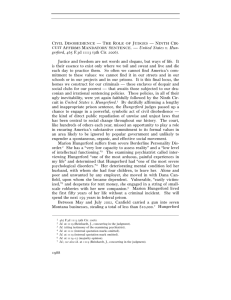Murder Mystery Lesson Plan
advertisement
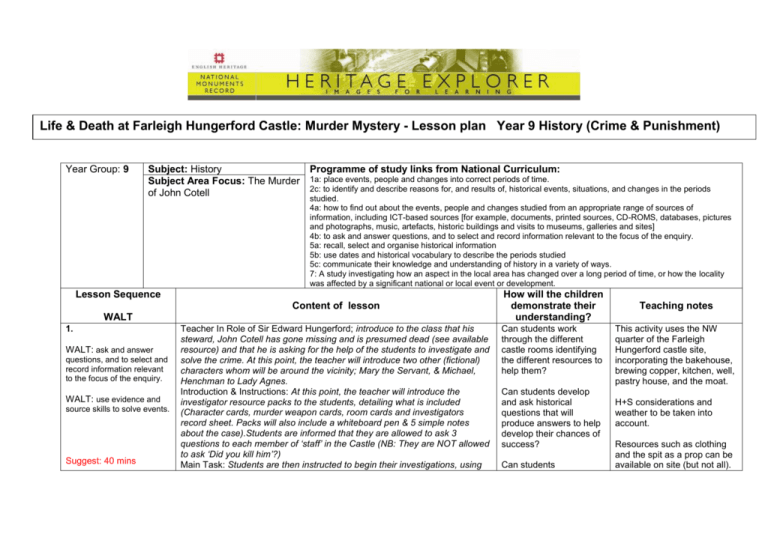
Life & Death at Farleigh Hungerford Castle: Murder Mystery - Lesson plan Year 9 History (Crime & Punishment) changed666 Year Group: 9 Subject: History Programme of study links from National Curriculum: Subject Area Focus: The Murder 1a: place events, people and changes into correct periods of time. 2c: to identify and describe reasons for, and results of, historical events, situations, and changes in the periods of John Cotell studied. 4a: how to find out about the events, people and changes studied from an appropriate range of sources of information, including ICT-based sources [for example, documents, printed sources, CD-ROMS, databases, pictures and photographs, music, artefacts, historic buildings and visits to museums, galleries and sites] 4b: to ask and answer questions, and to select and record information relevant to the focus of the enquiry. 5a: recall, select and organise historical information 5b: use dates and historical vocabulary to describe the periods studied 5c: communicate their knowledge and understanding of history in a variety of ways. 7: A study investigating how an aspect in the local area has changed over a long period of time, or how the locality was affected by a significant national or local event or development. Lesson Sequence Content of lesson WALT 1. WALT: ask and answer questions, and to select and record information relevant to the focus of the enquiry. WALT: use evidence and source skills to solve events. Suggest: 40 mins Teacher In Role of Sir Edward Hungerford; introduce to the class that his steward, John Cotell has gone missing and is presumed dead (see available resource) and that he is asking for the help of the students to investigate and solve the crime. At this point, the teacher will introduce two other (fictional) characters whom will be around the vicinity; Mary the Servant, & Michael, Henchman to Lady Agnes. Introduction & Instructions: At this point, the teacher will introduce the investigator resource packs to the students, detailing what is included (Character cards, murder weapon cards, room cards and investigators record sheet. Packs will also include a whiteboard pen & 5 simple notes about the case).Students are informed that they are allowed to ask 3 questions to each member of ‘staff’ in the Castle (NB: They are NOT allowed to ask ‘Did you kill him’?) Main Task: Students are then instructed to begin their investigations, using How will the children demonstrate their understanding? Can students work through the different castle rooms identifying the different resources to help them? Can students develop and ask historical questions that will produce answers to help develop their chances of success? Can students Teaching notes This activity uses the NW quarter of the Farleigh Hungerford castle site, incorporating the bakehouse, brewing copper, kitchen, well, pastry house, and the moat. H+S considerations and weather to be taken into account. Resources such as clothing and the spit as a prop can be available on site (but not all). all the rooms allocated on their maps in order to solve the mystery. Conclusion: After giving the students roughly 20-25 minutes allocated to investigating, draw the students back together in order to discuss their ideas and what they have found out. (NB: Here questioning relative to what led them to that conclusion can be introduced, developing their skills of working with sources). After all groups have discussed their ideas and their conclusions, Mary the Servant first asks whether students think the crime is real or not, before regaling the students with the true story (see available resource). An extra focus about Lady Agnes’ exemption from punishment for 4 years can spark an interesting Q+A section with students. G&T – take a leading role within the group. Solve the mystery, thinking about the reliability of the sources and evidence. SEN – Mixed ability groupings. Support through use of sources. Instruct weaker students to solve part of the mystery at first and then build on this success. Report findings at appropriate times to check understanding. EAL –.adult support to ensure they understand task, translation where appropriate. communicate their findings coherently? Part of Heritage Explorer Case Study Planning activities at an historical site; Farleigh Hungerford Castle Murder Mystery The idea is to present the activity in the kitchen before revealing the story in the bakehouse. Staff are in character throughout the activity.


